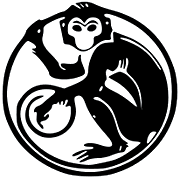Monkeys and Monkey Gods in Mythology, Folklore, and Religion.
by Anniina Jokinen

Monkey lore in India dates from before 500 BC.1 One of the most popular Hindu gods is Hanuman the Monkey, in some tales said to be an incarnation of Shiva. He is revered for his bravery, strength, loyalty, devotion, and dedication to justice. His tale and heroic exploits are told in both the Ramayana and the Mahabharata. It is common to chant the name of Hanuman when one needs heavenly intervention. Every year, his birthday is celebrated "on the full-moon day of Chaitra (April) at sunrise."2 Monkeys in general are revered in several parts of India, for bearing the likeness of Hanuman. He is connected to the sun, the wind, and thunder.
Monkey lore in China predates Buddhism, for the Monkey appears in the Chinese Zodiacal beliefs, believed by scholars to date to around 1100BC. In some parts of China, the Monkey (?) is worshipped as the "Great Sage Equal to Heaven."3 Of interest is also that the rough Western equivalent for the Chinese astrological sign of Monkey is the sign of Leo (which I am). In Chinese mythology, the monkey god was Sun-Wukong, the Monkey King, a trickster god. He is the hero of the 16th-century Chinese book Journey To The West (Xiyou Ji).4 The Monkey God Festival is still celebrated in China and Hong Kong.
Monkey lore in Japan took hold after the arrival of Buddhism (mid-6th century AD) and is tied to Japanese Shinto-Buddhism.5 The monkey was alternately a messenger to the gods or a physical manifestation of a god. The origin of the three monkeys, "Speak No Evil, Hear No Evil, See No Evil," is also thought to have originated at the Hiei Shrine at Mt. Hiei.6 In folklore and geomancy beliefs, the Monkey was thought to protect against demons as well as disease and is a patron of fertility, safe childbirth, and harmonious marriages.
Before moving away from the Far East, I'd like to quote Shumacher's summary of the monkey gods:
| Monkey mythology is an important part of both Hindu / Buddhist lore (India) and Zodiac / Taoist / Buddhist lore (China). In the various tales... the monkey is portrayed initially as foolish, vain, and mischievous. Yet, in each tradition, the monkey learns valuable lessons along the way, makes changes, and eventually gains redemption. The monkey thus embodies the themes of repentance, responsibility, devotion, and the promise of salvation to all who sincerely seek it.7 |
In the Americas, the Mayans of Guatemala and Mexico worshiped a howler monkey god ( sometimes depicted as twin-gods), who was the patron of the arts; music, scribes and sculptors.8 In the Mayan Calendar, the Howler Monkey corresponds to knowledge of history and rituals, as well as prophecy.9 There is a fabled "Ciudad Blanca" in Honduras, dedicated to the Monkey God, but so far its location is unknown—it is mentioned in pre-Columbian Toltec and Maya texts as "The ancient place where the aurora originates."10 In Aztec mythology of Mexico, the monkey was connected to the sun, and was guarded by Cochipilli (Kokopelli), the god of flower, fun, and fertility.
I was unable to find out anything about monkey beliefs in Africa. It is quite hard to imagine that a whole continent filled with monkeys would yield no monkey beliefs? Perhaps this just goes to show how disinterested the western world is in Africa in this as well as other areas. Please contribute if you possess any monkey information relating to Africa.
1 Monkey Deities. Mark Shumacher.
2 Hanuman, Simian symbol of strength. About.com
3 Monkey (Zodiac). Wikipedia entry.
4 Monkey. "Chinese Mythology." Godchecker.com.
5 Shumacher.
6 Ibid.
7 Ibid.
8 Howler Monkey Gods. Wikipedia entry.
9 Ibid.
10 Madrid, Ricardo. "White City legend has curious history."
Honduras This Week. 4 Sep 2001. 8 Mar 2007.
Article Citation:
Jokinen, Anniina. "Monkeys and Monkey Gods in Mythology, Folklore, and Religion."
Luminarium. 8 Mar 2007. [Date you accessed the page].
http://www.luminarium.org/mythology/monkeygods.htm
|

